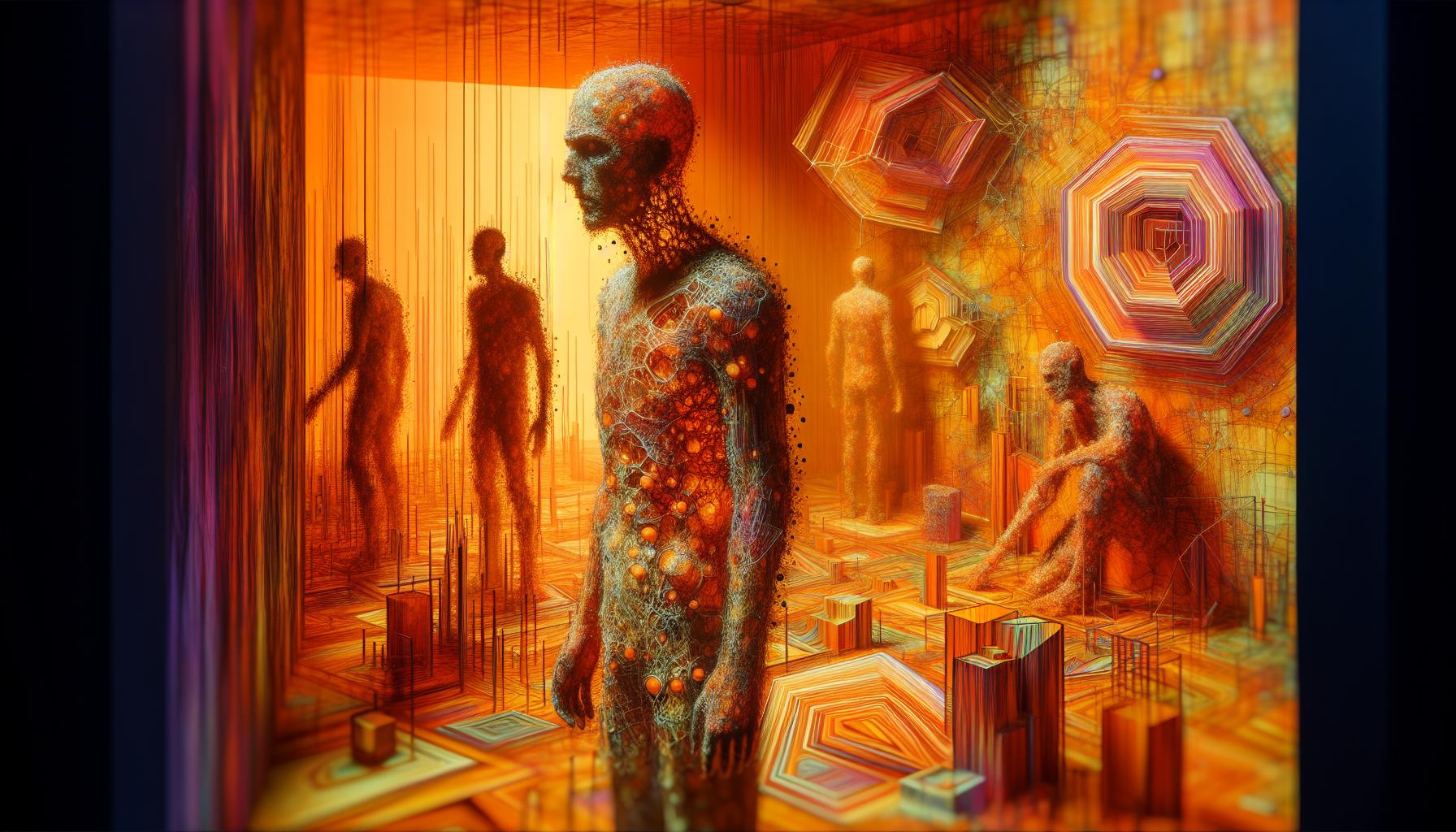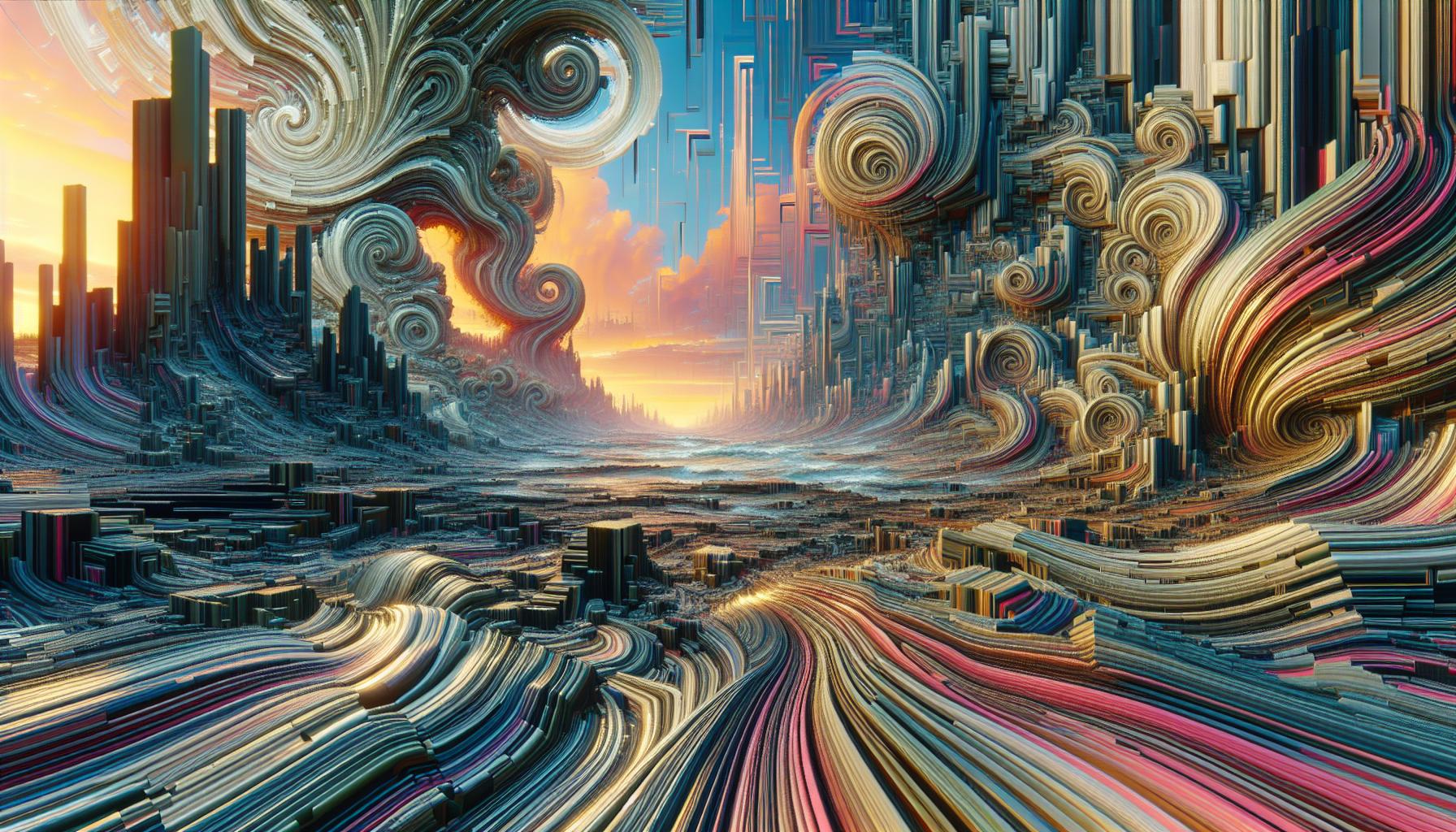Ever wondered why some abstract art sends shivers down your spine? In the mysterious world of creepy abstract art, artists transform ordinary shapes and colors into unsettling masterpieces that haunt viewers long after they’ve looked away. From distorted faces to eerily vacant landscapes these works tap into our deepest fears and psychological discomfort.
The intersection of horror and abstraction isn’t just about shock value – it’s a powerful artistic movement that’s gained momentum since the early 20th century. Today’s artists continue to push boundaries by creating pieces that blur the lines between beauty and terror. Whether it’s through unsettling color combinations twisted forms or cryptic symbolism these works challenge our perception of what art can be while making us question our own comfort zones.
Creepy Abstract Art
Abstract art transforms into unsettling imagery through specific artistic elements that trigger psychological discomfort in viewers. The combination of unconventional techniques creates a deeply disturbing visual experience that transcends traditional artistic boundaries.
The Psychology of Unsettling Imagery
Creepy abstract art activates the amygdala, the brain’s fear center, through ambiguous forms that prevent clear pattern recognition. Studies from neuroscience research reveal that incomplete or distorted human figures in abstract art generate heightened anxiety responses. The brain struggles to process these unclear visual elements, creating a state of sustained unease. Prominent artists like Francis Bacon exploit this psychological phenomenon by presenting familiar objects in unfamiliar contexts. Abstract compositions featuring asymmetrical patterns, fragmented shapes or isolated elements tap into primal fears of the unknown. Repetitive motifs in unsettling arrangements trigger pattern-recognition conflicts that leave viewers in a state of perceptual tension.
Color and Shadow Techniques
Artists manipulate color psychology to enhance the creepy aspects of abstract art through specific techniques. Dark color palettes featuring deep purples, muddy browns or toxic greens create immediate visual discord. Strategic use of high contrast between light and dark elements produces stark shadows that suggest hidden threats. Unnatural color combinations like acid yellows against deep reds generate instinctive feelings of danger. Artists employ color bleeding effects where hues seem to seep or drip across the canvas, suggesting decay or deterioration. Harsh lighting techniques cast dramatic shadows that transform recognizable shapes into menacing silhouettes. Color gradients that fade into darkness create undefined spaces that leave viewers feeling uncertain about what lurks in the shadows.
Famous Creepy Abstract Artists Through History

Several influential artists pioneered the fusion of abstract elements with disturbing imagery to create powerful emotional responses in viewers. These visionaries pushed artistic boundaries by transforming familiar forms into haunting masterpieces that continue to influence contemporary art.
Francis Bacon’s Disturbing Figures
Francis Bacon revolutionized abstract art through his grotesque portraits depicting distorted human forms in claustrophobic spaces. His 1953 piece “Study after Velázquez’s Portrait of Pope Innocent X” showcases a screaming papal figure trapped in geometric cage-like structures. The artist’s signature style emerged from his exploration of raw human emotions expressed through twisted flesh tones elongated limbs. Bacon’s works frequently featured isolated figures against dark backgrounds creating a sense of existential dread. His “Three Studies for Figures at the Base of a Crucifixion” (1944) demonstrates his mastery of creating psychological tension through warped anatomical forms painted in sickly orange hues.
H.R. Giger’s Biomechanical Nightmares
H.R. Giger created a distinctive artistic style blending organic forms with mechanical elements in monochromatic airbrushed paintings. His most recognized work “Necronom IV” (1976) inspired the iconic Alien creature design in Ridley Scott’s 1979 film. Giger’s artwork explores themes of birth technology death through intricate details merging human anatomy with industrial components. The artist’s paintings feature recurring motifs of elongated skulls cybernetic implants sexual imagery. His masterpiece “Li I” (1974) exemplifies his signature biomechanical style with its seamless integration of pipes tubes into humanoid forms creating an unsettling visual landscape that challenges conventional artistic boundaries.
Common Themes in Dark Abstract Art

Dark abstract art encompasses recurring motifs that amplify psychological discomfort through specific artistic techniques. These themes manifest across different artists’ works, creating a distinctive vocabulary of unsettling imagery.
Distortion and Fragmentation
Dark abstract artists manipulate familiar forms into disconcerting configurations through deliberate distortion techniques. Human figures transform into twisted masses of flesh, while everyday objects break apart into jagged shards. The fragmentation process disrupts visual expectations by shattering recognizable shapes into scattered elements across the canvas. Artists employ techniques like stretching, warping, or dissolving forms to create unsettling variations of familiar subjects. This approach generates cognitive dissonance as viewers struggle to reconcile the fractured imagery with their understanding of natural forms.
Surreal Elements
Surreal components in dark abstract art merge impossible combinations of objects, creatures, or environments. Artists incorporate floating body parts, morphing landscapes, or hybrid beings that defy biological constraints. The artwork often features incongruous scale relationships, such as microscopic details blown up to massive proportions or towering figures shrunk to miniature size. Environmental elements blend seamlessly into living forms, creating dreamlike scenes where walls melt into flesh or machinery fuses with organic matter. These surreal juxtapositions tap into subconscious fears by presenting scenarios that violate natural laws while maintaining an internal visual logic.
The Rise of Digital Creepy Abstract Art

Digital technology transforms creepy abstract art through innovative tools that enable artists to create unsettling pieces with unprecedented precision. Software applications like Adobe Photoshop, Procreate, and ZBrush provide artists with capabilities to manipulate forms, textures, and colors in ways previously impossible through traditional mediums.
Artificial Intelligence platforms generate disturbing abstract compositions by analyzing patterns from existing horror art databases. Neural networks like DALL-E and Midjourney produce uniquely unsettling imagery by combining elements from thousands of artworks, creating pieces that tap into uncanny valley effects.
Virtual Reality expands the boundaries of creepy abstract art by immersing viewers in 360-degree environments. Artists like Rachel Rossin create interactive digital landscapes filled with distorted shapes and glitch effects that surround viewers in disorienting spaces.
Key Digital Art Platforms:
- Cinema 4D: Creates hyperrealistic distortions of organic forms
- TouchDesigner: Generates real-time abstract animations with unsettling movement
- Unity: Builds interactive horror experiences with abstract elements
- Blender: Produces surreal 3D sculptures with disturbing textures
Digital Tools Impact on Abstract Horror:
| Technology | Effect on Art |
|---|---|
| AI Generation | Creates unpredictable distortions |
| 3D Modeling | Enables impossible geometries |
| Glitch Art | Produces unsettling visual errors |
| Particle Systems | Simulates organic decomposition |
NFT marketplaces expand the reach of digital creepy abstract art through blockchain technology. Artists like Beeple incorporate haunting abstract elements into their crypto art collections, selling pieces for substantial sums while establishing new platforms for disturbing digital expression.
Impact on Horror and Gothic Culture
Creepy abstract art transformed horror aesthetics by introducing psychological elements that transcend traditional monster imagery. Gothic subcultures embrace abstract horror art’s ability to convey existential dread through non-representational forms. Fashion designers incorporate distorted patterns from abstract horror pieces into clothing lines, creating garments that feature asymmetrical cuts and unsettling color combinations.
Horror film productions draw inspiration from abstract art’s manipulation of space and form. Directors like Dario Argento use abstract color schemes in movies such as “Suspiria” to create atmospheric tension. Video game developers integrate abstract horror elements into game environments, establishing psychological horror through fragmented landscapes and distorted perspectives.
Gothic music scenes feature album artwork influenced by creepy abstract designs. Bands incorporate these visual elements into:
- Stage productions with projected abstract imagery
- Music video aesthetics featuring morphing shapes
- Concert promotional materials using distorted forms
- Merchandise designs with surreal elements
Modern gothic architecture adopts principles from abstract horror art through:
- Irregular geometric patterns in facade designs
- Unconventional spatial arrangements
- Dramatic lighting schemes that create shadow play
- Integration of unsettling textural elements
| Impact Area | Notable Examples | Year Introduced |
|---|---|---|
| Film | Suspiria | 1977 |
| Gaming | Silent Hill Series | 1999 |
| Fashion | Alexander McQueen’s Horn of Plenty | 2009 |
| Architecture | Kunsthaus Graz | 2003 |
The influence extends into literature where contemporary horror writers describe scenes using abstract concepts rather than concrete monsters. Book cover designs increasingly feature minimalist abstract horror elements that suggest psychological terror through simple yet disturbing compositions.
Creepy abstract art stands as a powerful testament to humanity’s ability to evoke profound emotional responses through non-traditional artistic expression. This genre continues to evolve with technological advancements while maintaining its core ability to unsettle and intrigue viewers through psychological triggers.
The fusion of digital innovation with traditional abstract horror techniques has opened new frontiers for artists to explore the depths of human discomfort. As this art form permeates various cultural spheres it’s clear that its influence extends far beyond gallery walls shaping contemporary expressions of fear and uncertainty in unexpected ways.
The enduring appeal of creepy abstract art lies in its unique ability to tap into universal human fears while challenging conventional artistic boundaries. It remains a vital force in modern creative expression proving that sometimes the most powerful fears are those that defy clear definition.



